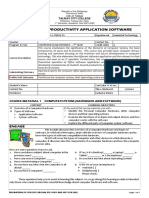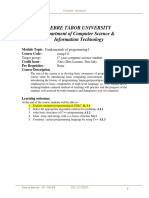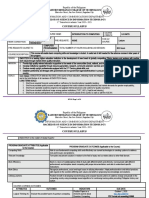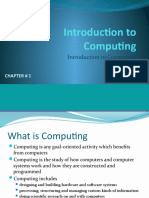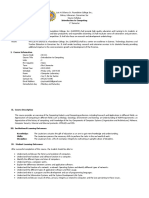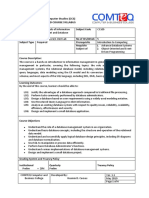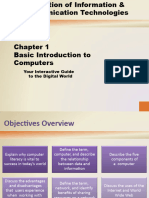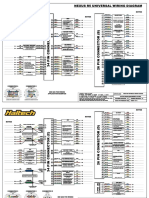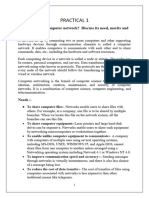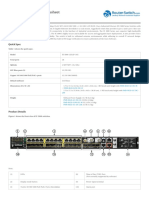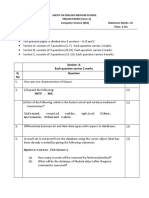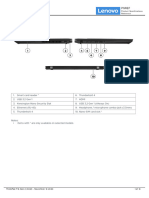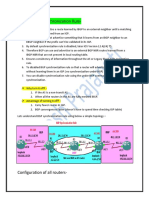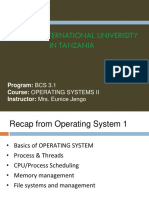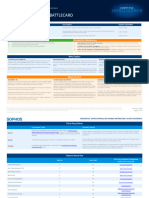Discovering
Computers
Living in a Digital World
�Objectives Overview
Define the term,
Explain why computer computer, and describe Describe the five
literacy is vital to the relationship components of a
success in today’s world between data and computer
information
Discuss the advantages
Define the term,
and disadvantages that Discuss the uses of the
network, and identify
users experience when Internet and World
benefits of sharing
working with Wide Web
resources on a network
computers
2
�Objectives Overview
Distinguish between system Differentiate among types, Describe the role of each
software and application sizes, and functions of element in an information
software computers in each category system
Explain how home users,
Discuss how society uses
small office/home office
computers in education,
users, mobile users, power
finance, government, health
users, and enterprise users
care, science, publishing,
each interact with
travel, and manufacturing
computers
3
�A World of Computers
• Computers are everywhere
Pages 4 - 5 4
Figure 1-1
�What Is a Computer?
• A computer is an electronic device, operating
under the control of instructions stored in its own
memory
Collects Produces
data Processing information
(input) (output)
Information Processing Cycle
Page 6 5
�What Is a Computer?
Page 6 6
Figure 1-2
�The Components of a Computer
• A computer contains many electric, electronic, and
mechanical components known as hardware
Input Device • Allows you to enter data and instructions into a computer
Output Device • Hardware component that conveys information to one or more people
• Case that contains the electronic components of the computer that
System Unit are used to process data
Storage Device • Holds data, instructions, and information for future use
Communications • Enables a computer to send and receive data, instructions, and
Device information to and from one or more computers or mobile devices
Pages 6 - 8 7
Chapter 1
�The Components of a Computer
Page 7 8
Figure 1-3 Chapter 1
�Advantages and Disadvantages
of Using Computers
Advantages of Disadvantages of
Using Computers Using Computers
Speed Health Risks
Reliability Violation of Privacy
Consistency Public Safety
Storage Impact on Labor Force
Communications Impact on Environment
Pages 9 - 10 9
Chapter 1
�Advantages and Disadvantages
of Using Computers
• Green computing involves reducing the electricity
consumed and environmental waste generated when
using a computer
• Strategies include:
– Recycling
– Regulating manufacturing processes
– Extending the life of computers
– Immediately donating or properly disposing of replaced computers
Page 10 10
Chapter 1
�Networks and the Internet
• A network is a
collection of computers
and devices connected
together, often
wirelessly, via
communications
devices and
transmission media
Pages 10 - 11 11
Chapter 1
Figure 1-6
�Networks and the Internet
• The Internet is a worldwide collection of networks that
connects millions of businesses, government agencies,
educational institutions, and individuals
Page 11 12
Figure 1-7
�Networks and the Internet
• People use the Internet for a variety of reasons:
Communicate Research and Shop Bank and Invest Online Trading
Access Information
Entertainment Download Videos Share Information Web Application
Pages 12 - 13 13
Figure 1-8
�Networks and the Internet
• A social networking Web site encourages
members to share their interests, ideas, stories,
photos, music, and videos with other registered
users
Page 14 14
Figure 1-9
�Computer Software
• Software, also called a program, tells the
computer what tasks to perform and how to
perform them
System Software
• Operating system
• Utility program
Application Software
Pages 15 - 16 15
Figures 1-10 - 1-11
�Computer Software
• Installing is the process of setting up software to
work with the computer, printer, and other
hardware
Pages 16 - 17 16
Figure 1-12
�Computer Software
• A programmer develops
software or writes the
instructions that direct
the computer to
process data into
information
Page 18 17
Figure 1-13
��Categories of Computers
Personal computers
Mobile computers and mobile devices
Game consoles
Servers
Mainframes
Supercomputers
Embedded computers
Page 19 18
�Personal Computers
• A personal computer can perform all of its input,
processing, output, and storage activities by itself
• Two popular architectures are the PC and the
Apple
– Desktop computer
Page 19 19
Figures 1-15 - 1-16
�Mobile Computers and Mobile Devices
Mobile Mobile
Computer Device
Personal computer you Computing device
can carry from place to small enough to hold in
place your hand
Examples include
Examples include
smart phones, PDAs,
notebook computers,
handheld computers,
laptop computers,
portable media
netbooks, ultra-thins,
players, and digital
and Tablet PCs
cameras
Pages 20 - 23 20
�Mobile Computers and Mobile Devices
Notebook computer
Tablet PC
Smart phone
PDA
Pages 20 - 22 21
Figures 1-17 – 1-20
�Mobile Computers and Mobile Devices
Handheld computer
Portable media player
Digital camera
Pages 22 - 23 22
Figures 1-21 – 1-23
�Game Consoles
• A game console is a
mobile computing
device designed for
single-player or
multiplayer video
games
Page 24 23
Figure 1-24
�Servers
• A server controls access
to the hardware,
software, and other
resources on a network
– Provides a centralized
storage area for
programs, data, and
information
Page 25 24
Figure 1-25
�Mainframes
• A mainframe is a large,
expensive, powerful
computer that can
handle hundreds or
thousands of connected
users simultaneously
Page 25 25
Figure 1-26
�Supercomputers
• A supercomputer is the fastest, most powerful
computer
– Fastest supercomputers are capable of processing
more than one quadrillion instructions in a single
second
Page 25 26
Figure 1-27
�Embedded Computers
• An embedded computer is a special-purpose
computer that functions as a component in a
larger product
Consumer Home Automation Process Controllers Computer Devices
Automobiles
Electronics Devices and Robotics and Office Machines
• Mobile and digital • Thermostats • Antilock brakes • Remote monitoring • Keyboards
telephones • Sprinkling systems • Engine control systems • Printers
• Digital televisions • Security modules • Power monitors • Faxes
• Cameras monitoring systems • Airbag controller • Machine • Copiers
• Video recorders • Appliances • Cruise control controllers
• DVD players and • Lights • Medical devices
recorders
• Answering
machines
Page 26 27
�Embedded Computers
Page 26 28
Figure 1-28
�Elements of an Information System
Hardware Software Data
People Procedures
Page 27 29
�Elements of an Information System
Page 27 30
Figure 1-29
�Examples of Computer Usage
Home User Small Office/Home Mobile User
• Personal financial management Office User • Connect to other computers on
• Web access • Look up information a network or the Internet
• Communications • Send and receive e-mail • Transfer information
• Entertainment messages • Play video games
• Make telephone calls • Listen to music
• Watch movies
Pages 28 – 31 31
Figures 1-30 – 1-32
�Examples of Computer Usage
Power User Enterprise User
• Work with multimedia • Communicate among
• Use industry-specific employees
software • Process high volumes
of transactions
• Blog
Pages 31 – 32 32
Figures 1-33 – 1-34
�Computer Applications in Society
Education
Finance
Government
Health Care
Pages 34 - 36 33
Figures 1-36 – 1-39
�Computer Applications in Society
Science
Publishing
Travel
Manufacturing
Pages 36 - 38 34
Figures 1-40 – 1-43
�Video: Computer History in a Barn
35
�Summary
Basic computer Components of a
concepts computer
Many different
categories of
Networks, the Internet,
computers, computer
and computer software
users, and computer
applications in society
Page 39 36
�Discovering
Computers
Living in a Digital World
Chapter 1 Complete





